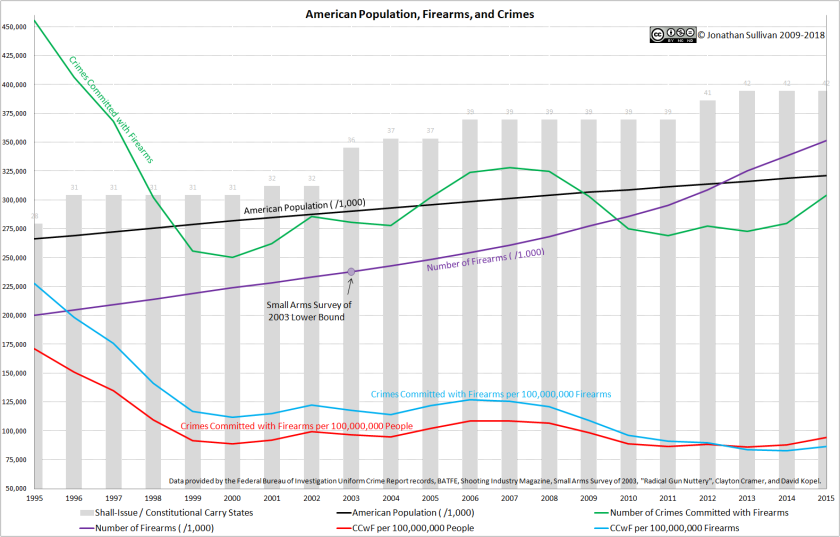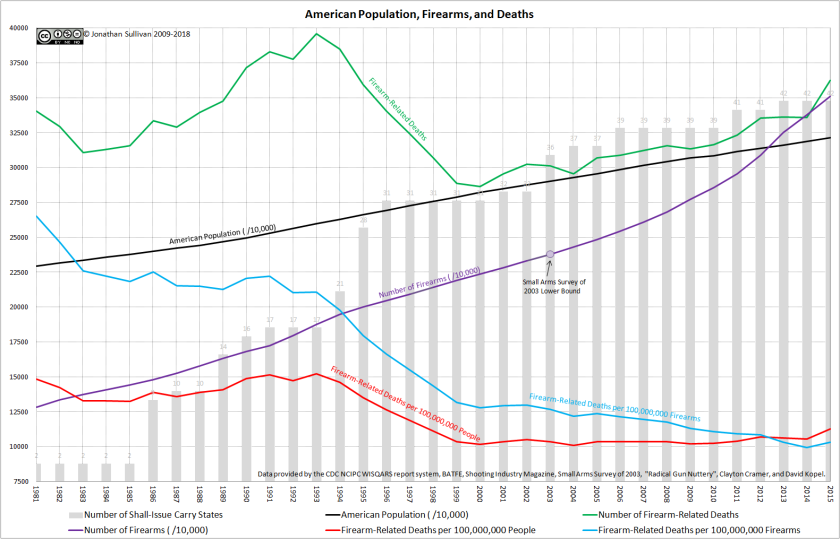One of the favorite myths of “gun control” advocates is that as the number of firearms in Americans’ hands increases, so too does the number of firearm-related deaths increase. Superficially, this seems to make sense, and thus it is an appealing fiction to buy into.
Fortunately, the actual data proves the hypothesis to be false.
To begin with, I should clarify that we will be considering the rates of firearm ownership and rates of firearm-related fatalities, since raw numbers are affected by population growth or decline. Thankfully, the United States population is fairly well documented, and we will be using the Centers for Disease Control‘s information.
Additionally, causes of death are also well documented, also by the CDC. Their WISQARS Fatal Injury Reports are updated on a yearly basis, and their data set spans from 1981 to 2012, so that will be our consideration window.
Unfortunately (from the analytical standpoint), the first part of the equation – the number of firearms in private Americans’ hands – is nowhere near as accurately recorded. Obviously I am quite sanguine with the federal government having no idea who owns what firearms or in what numbers, but it does make statistical examinations a little more challenging. However, the Small Arms Survey of 2003 is perhaps an authoritative estimate on private ownership of arms in various nations, and they calculate the lower bound of US firearm numbers in 2003 as approximately 238,000,000. The Small Arms Survey organization is decidedly against the “proliferation of small arms”, by their own words, so we have every reason to believe they inflate their numbers for greater impact, but we can accept that as a starting point.
From that starting point, we will add, or subtract, the firearm production figures provided by the Bureau of Alcohol, Tobacco, Firearms and Explosives‘ Firearms Commerce in the United States document, at least as far back as 1986 (the earliest publication of that document). Before then, we will rely on the Shooting Industry News.
Finally, while it does not factor into the “does ‘more firearms’ mean ‘more firearm-related deaths?” question, the number of “shall-issue” and “Constitutional carry” states is also included in the data, with the tallying done by Radical Gun Nuttery (their *.gif documenting the march of our rights across the nation is quite handy).
So, with all this data at our fingertips, does “more firearms = more firearm-related deaths” hold true?

In short, no.
For those who want more than pretty pictures, when one considers the rates – i.e. the number of firearms or firearm-related fatalities per 10,000 people – the rate of firearm ownership correlates to the rate of firearm-related fatalities with a coefficient of -0.80155, indicating a strong, negative correlation between the two data sets.
Even when you look at the raw numbers, the number of firearms in America correlated to the number of firearm-related fatalities – i.e. “gun deaths” – with a coefficient of –0.36471, which still indicates a negative correlation between those two data sets.
At this point, it is important to clarify that correlation does not indicate, nor prove, causality… but I am not attempting to prove causality here. However, by stating that “more guns causes more ‘gun deaths'”, the anti-rights community is attempting to claim causality, and one that would outright require positive correlation.
No such positive correlation exists.
As such, the hypothesis of “more guns = more ‘gun deaths'” cannot be true.
Feel free to spread this information as far as you like, and if you are so inclined, I welcome people checking my work (*.xlsx file). Unlike anti-firearms organizations, I make no attempt at hiding my raw data, or the ways it was crunched.
(As a further aside, it would not matter if the hypothesis could be true – the overwhelming majority of firearm-owning Americans have broken no laws nor harmed anyone, and, as such, no one has any standing to unjustly deprive them of property or rights.)





